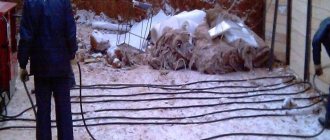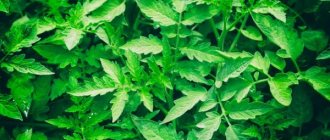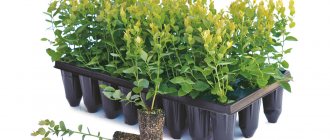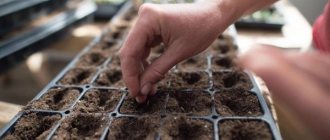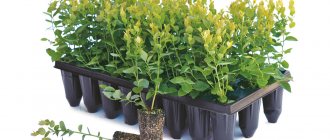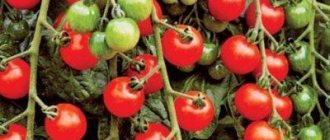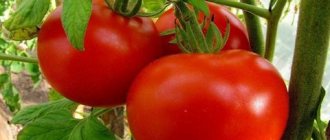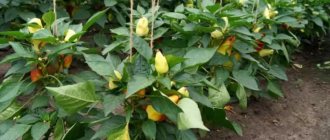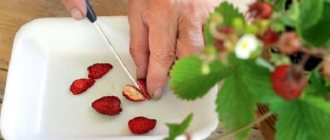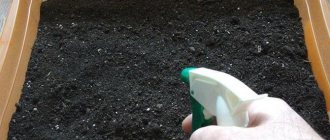Soil or soil is the main source of chemical elements that a plant consumes during its active growth. It has a special property called “fertility”, due to which it provides plants not only with useful substances, but also participates in creating the optimal temperature and humidity conditions for the plant’s root system . And young seedlings, more than adult plants, require good nutrition and conditions suitable for development.
Store-bought soil for seedlings
Natural soil, which can be collected from your garden, does not always contain the required amount of elements necessary for seedlings, and its structure may be too “rough” for a young plant, so gardeners either prepare the soil themselves, improving the physical and chemical characteristics of the country soil, or purchase ready-made soil in specialized stores.
TOP 10 best soils for seedlings
| Photo | Name | Rating | Price | |||
| TOP 5 best soils for seedlings | ||||||
| #1 | "Bogatyr" | ⭐ 4.95 / 5 32 - votes | Find out the price | |||
| #2 | "BioGrunt ECOflora for seedlings" | ⭐ 4.9 / 5 12 — votes | Find out the price | |||
| #3 | “Strong for tomatoes, peppers, eggplants” (Fasco) | ⭐ 4.85 / 5 44 - votes | Find out the price | |||
| #4 | “Gardener, soil for seedlings of vegetables and flower crops” | ⭐ 4.8 / 5 20 — votes | Find out the price | |||
| #5 | "BioGrunt KEVA" (Bioterra) | ⭐ 4.75 / 5 19 — votes | Find out the price | |||
| TOP 5 brands of ready-made greenhouse soils for vegetable crops | ||||||
| #1 | “Vegetable universal”, BIUD | ⭐ 4.95 / 5 2 - votes | Find out the price | |||
| #2 | "Living Earth Terra Vita" | ⭐ 4.9 / 5 120 — votes | Find out the price | |||
| #3 | Nutrient soil Polya Russkie “Biohumus for vegetables, universal” | ⭐ 4.8 / 5 10 — votes | Find out the price | |||
| #4 | Universal soil primer "Good Power" | ⭐ 4.75 / 5 8 — votes | Find out the price | |||
| #5 | "Sapropel, Siberian organics" | ⭐ 4.7 / 5 11 — votes | Find out the price | |||
What soil for seedlings will you choose or recommend?
Take the survey
Characteristics of good soil - a little theory
Most vegetables and many flowers can be produced from seedlings (eg tomatoes, peppers, lettuce, celery, leeks, cucumbers, cabbage, eggplant), but all will require a good quality substrate for the seeds to germinate and the seedlings to develop properly.
You can prepare the soil for growing seedlings yourself or buy it at a garden center. Prepared substrates are more expensive, but usually have a better composition and are more convenient to use.
Parameters of a good substrate
Seedlings of vegetables, flowers, and ornamental plants are grown in organic media. What soil is best for seedlings? Good soil should have the following qualities:
- free from pathogens to which seedlings are very sensitive (disinfected);
- finely structured;
- light, airy, water-permeable, which promotes good gas exchange with the environment and does not cause excessive water retention;
- with high moisture capacity;
- must have an appropriate reaction;
- must contain optimal amounts of nutrients for the growth and development of individual plant species.
There is information in the literature that to ensure normal plant growth, the organic substrate must be prepared in the following way:
- solids – 10-30% volume;
- air – 30-40%;
- water – 40-50%.
The soils in which seedlings are grown should not have as much air exchange as soil intended for permanent cultivation, but it is good if they contain more than 20% air after watering.
The basis of the soil is high acid peat
High acidic peat has a high acidity pH (2.5 – 4.5) and a light brown color. Currently, seedlings are grown mainly on substrates prepared from various fractions of high-moor peat, and other organic materials, such as low-lying peat or pine bark, are used less frequently for this purpose. Substrates with a high peat content are the best soils for growing seedlings, provided they are properly prepared and stored, since they are then free from pathogens, pests, and weed seeds, to which young plants are especially sensitive.
Substrates are mainly prepared by specialized companies and delivered to manufacturers in packages of various sizes. Such substrates are usually homogeneous in the composition of individual fractions and adapted to subsequent stages and technology for producing seedlings. Companies producing peat substrates use for their production appropriate mixtures of several types of peat, obtained in different ways and of different granulations:
- 0-10 mm - small,
- 0-20 mm - standard,
- 0-40 mm - large.
The physical properties of the substrate, such as the ability to retain water and its movement in the substrate, depend on the content of individual fractions. If the structure of the substrate is poor, capillary spaces do not form in containers filled with it; as a result, water seeps into the bottom of the pot in one place, and the soil is dry in another.
The moisture content of the peat is also important when grinding it. Peat that is crushed in a too dry state contains a lot of very fine particles - dust, which prevents the substrate from properly absorbing water.
All substrates are enriched with nutrients, usually supplied in the form of multi-component fertilizers. A surfactant is also added to light peat substrates to maintain uniform moisture content throughout the container.
Ready-made soil has an expiration date. It is a material that constantly undergoes chemical changes caused by microorganisms, which occur faster the higher the temperature and humidity during storage. Therefore, the packaging of substrates must indicate the date of manufacture and batch number for identification in case of return.
Reputable manufacturers of substrates for growing seedlings recommend:
- do not store the substrate for longer than 3 months;
- protect the stored substrate from the sun and rain;
- Do not use substrates overgrown with fungi and algae.
When preparing substrates for the production of seedlings, you should independently use high-moor peat, which retains its properties for a long time during transportation and storage in its raw form.
Should I use lowland peat?
Lowland peat, extracted from shallow layers of meadows and garden soils, obtained by composting various organic materials, is a substrate with very different physical and chemical properties. Some growers still use it to grow seedlings, seeing some savings in this. However, it often turns out that preparing seedlings on such substrates is more expensive than in soil made from high-moor peat.
Soils made from low-lying peat can be bad for seedlings and provoke poor plant growth for various reasons:
- runoff of fertilizer from surrounding fields onto the meadows from which peat is extracted, which can occur after heavy rains;
- the use of microbiologically contaminated substrate when composting diseased parts of plants and weeds; The seeds of some types of weeds remain viable for several decades.
Basic soil requirements
Soil for seedlings sold in stores varies:
- universal, which, according to the information on the packaging, is suitable for all types of plants;
- special - manufacturers make its composition optimal for any type of crop (for example, soil for peppers, tomatoes, flowers, etc.).
Soil for seedlings can be purchased in specialized stores.
Special soil is not a marketing ploy or an attempt to deceive the consumer. The fact is that the composition of such soil is optimal for a certain crop: each species, be it pepper, tomato, eggplant, requires a certain amount of nutrients and soil structure in order to develop well and gain strength. In special soils the necessary balance is maintained, while in universal soils some fertilizer may have to be added.
Sapropel is a unique natural compound formed at the bottom of natural reservoirs, used as an improving additive on all types of soils
And although the soils sold in stores have different compositions, when making your choice, remember the basic requirements that apply to seedling soil.
- Looseness . Pay attention to the physical shape of the soil - it should not be lumpy. For seedlings, the soil should be airy and even soft. The mixture should not harden or cake
- Health . The soil may contain many useful substances, but if fungal spores, pathogens, insect larvae, and weed sprouts are found in it, then this substrate is no good. Weak young plants will not cope with such a “biological” attack and will die.
- Fertility . The soil must contain the microelements necessary for the plant, otherwise the seedlings will not be able to feed.
- Acidity . This property of the soil should be close to neutral pH, that is, equal to 6.5-6.7. It is harmful for tiny plants to be in an acidic or alkaline environment.
- Toxicity . The soil must not contain petroleum products, heavy metal salts, or radionuclides.
The soil must meet certain requirements
Many of these indicators are difficult to evaluate at home, and therefore it is not always possible to comply with all soil requirements. Ideally, to determine how suitable the soil is for planting seeds for seedlings, you need to submit it for analysis to a laboratory. But, since this is not always possible, it is worth choosing proven brands in stores.
What soil is best suited for seedlings?
Even in store-bought soils, a certain soil will be the base, so it is important to know which soil is best suited for seedlings. There are two possible answers to this question:
- The top layer of black soil. It is rich in nutrients, retains water well and has excellent breathability. Chernozem can be used for seedlings with almost no preparation.
- Peat soils are rich in nutrients, but conduct air less well. The soil under the seedlings will become crusty, so you need to ensure regular loosening.
Sandy soil is not at all suitable for growing seedlings. It can only be used to prepare a soil mixture, enriching it with humus. For better water absorption, vermiculite or its analogue is added to this composition.
If you want to grow strong seedlings, do not use soil alone. Even black soil needs supplements, albeit in small quantities.
How to choose soil
With such variety, how can you choose the right soil for your seedlings? Follow the instructions below and you'll be fine:
- Decide which primer is better to take - universal or special. We wrote above about the advantages of special soil, but if you are new to gardening, it is better to use universal soil.
- The package with the selected primer must have a label or print that gives all the instructions for using the primer, indicating its chemical and mechanical composition, and information about the manufacturer. If there is no description of the soil on the package, then it is better to refuse to purchase it, no matter how hard the seller advises you of it.
Instructions for using the primer are on the back of the primer package. - The most important thing is to evaluate the chemical composition. Good soil should have 3-4 components. Ideally, the soil for seedlings should contain a couple of types of peat, vermiculite or sand, and mineral fertilizer. The chemicals needed by the plant must be in moderate quantities, that is, if phosphorus, nitrogen, potassium contains 300-400 mg/l, then such soil will need to be slightly diluted for some types of plants. Or you can take less nutritious soil and then feed the plants.
- It is also important to evaluate the mechanical composition: buy one package of soil and see what it is like. The soil should be loose, not greasy, well permeable to water and without large lumps.
Buy a sample pack of soil at the store and check its condition - Ideally, the soil should be taken to a laboratory for testing so that a specialist can accurately assess its suitability for use and the absence of all kinds of harmful substances and pathogenic microflora.
Considering the packaging
Having meticulously studied the inscriptions on the packages, we will see that in all soils the base is approximately the same and consists of the elements discussed above. So what is the difference between them then and which mixture should you choose? In my opinion, it is the composition, quantity and quality of fertilizers used that distinguishes one product from another.
The amount of fertilizer in the soil was not taken out of thin air by manufacturers; it is designed for 1-2 weeks of seedling development after planting the seeds. On the packaging you will find the inscription “N: P: K”, which indicates the content of the main nutrients - nitrogen, phosphorus and potassium.
The main thing to pay attention to is the amount of nitrogen. This is a case where more is not better. Seeds do not need a lot of nitrogen to start. Increased doses of fertilizers provoke rapid growth, but affect the immune system and do not guarantee high yields in the future. Small ones do not provide adequate nutrition and require earlier and richer feedings.
The ratio of macroelements in soils for seedlings is calculated specifically for young plants. The nutrient content will satisfy the needs of even demanding crops in this regard - cabbage, tomatoes, eggplants, pumpkins.
The soil packaging indicates the content of essential nutrients
It is undesirable to use universal and flower soils with a nitrogen content of 300-350 mg/l or higher for seedlings; they are only good for adult plants.
In addition to macroelements (nitrogen, phosphorus and potassium), plants also need microelements - magnesium, boron, copper, iron, zinc, etc. The microelement complex should be in chelated form, which is more easily absorbed by plants, especially young seedlings.
Seedlings better absorb microelements in chelated form
There is one more nuance. Sometimes manufacturers do not add a complex fertilizer, but a mixture of individual ingredients - superphosphate, ammonium nitrate, for example. When you put the soil in small pots, it may turn out dense in some places and empty in others. High-quality fertilizer contains the entire complex of useful substances in each particle and is evenly distributed throughout the entire volume of soil. This information can also be read on the primer package.
The composition of the soil takes into account the needs of nightshade crops for macro- and microelements, ideal for picking tomatoes
Tips for gardeners
Some tests to determine the quality of the soil can be carried out at home, and you can also prepare the soil for planting seeds at home.
- To determine acidity, place a piece of clean glass on a dark surface, and then sprinkle the soil from the bag onto the surface of the glass and pour vinegar (9%). The level of foaming will help to assess the acidity: if there is none at all, then the soil is acidic, if its amount is relatively small, then the soil is neutral. Alkaline soil will produce copious amounts of foam.
- It is important to disinfect even high-quality soil before use. To do this, dilute 3 grams of potassium permanganate in 10 liters of water and water the soil.
Don't forget about soil disinfection - If the soil falls out of the bag in a lump and does not pour out neatly, then add a little sawdust to the soil to improve its mechanical properties.
- If you don’t trust soil from the store, then your option is to prepare the soil yourself using soil from your garden.
Criteria for choosing soil for seedlings
Video - Instructions for choosing soil for seedlings
Purchasing a ready-made option
Some stores sell ready-made specimens for specific plants. When purchasing this product, it is important to understand that it must be used for its intended purpose. For example, if the mixture is intended for peppers, then it should be used for peppers. No other plants will take root, even if someone managed to do the opposite, it’s not worth the risk, because the person will waste not only money, but also time, and will be left without a harvest.
If the products are used as intended, the gardener will quickly become convinced that this land is the most favorable for seedlings. The secret of such a product is that the composition for a specific plant is observed. There are no unnecessary microelements that inhibit development. But when purchasing this option, it is important to know the right manufacturer, because not all companies strive for quality, which is why their land quickly ends up on the gardener’s blacklist.
User voting
What soil for seedlings will you choose or recommend?
"Bogatyr"
11.51 % ( 32 )
"BioGrunt ECOflora for seedlings"
4.32 % ( 12 )
“Strong for tomatoes, peppers, eggplants” (Fasco)
15.83 % ( 44 )
“Gardener, soil for seedlings of vegetables and flower crops”
7.19 % ( 20 )
"BioGrunt KEVA" (Bioterra)
6.83 % ( 19 )
“Vegetable universal”, BIUD
0.72 % ( 2 )
"Living Earth Terra Vita"
43.17 % ( 120 )
Nutrient soil Polya Russkie “Biohumus for vegetables, universal”
3.60 % ( 10 )
Universal soil primer "Good Power"
2.88 % ( 8 )
Basic composition of ready-made soils
The basis of most soils is a mixture of high-moor and low-lying peat. What is the difference between these components?
High peat has high moisture capacity, looseness and porosity and is responsible for supplying the roots with air and water. At the same time, there is practically no organic matter available to plants. The now fashionable coconut substrate has the same properties. But we have a lot of peat bogs in our country, but somehow things didn’t work out with coconuts - so peat products are cheaper and easier to find.
Lowland peat enriches the soil with nutritious organic matter, but has low air permeability. Thus, we can conclude that both types of peat in the mixture complement each other.
Do not forget that high-moor peat has high acidity. Among plants, there are, of course, lovers of “sourness,” but most vegetable and flower crops are not one of them. Therefore, the composition must contain a deoxidizing agent - dolomite flour, lime or ash. In industrially produced mixtures, dolomite is usually used to bring the pH to 6-7.
The composition from “Fasco” contains everything that is necessary for seedlings, the pH is normal
Yandex.RTB RA-1479455-8
To increase looseness, so that after numerous waterings the peat does not become compacted and caking, coarse river sand, agroperlite or vermiculite are also added to the soil.
The standard peat mixture, of course, is rich in organic matter, but young lichens are not able to fully absorb the necessary substances from it. Therefore, you need to either constantly feed them, or purchase soil that already contains a starter set of mineral fertilizers.
Rating of inexpensive brands
Nov-Agro
A popular company that is found in all specialized stores and is one of the largest manufacturers of gardening products for 2022. Not only soil for seedlings is available on sale, but also hundreds of useful fertilizers, nutrients, etc. All products are manufactured in accordance with Russian requirements; there are no unnecessary additives here.
The average price is 35 rubles.
soil Nov-Agro
Advantages:
- Good production;
- Low cost;
- Popular brand;
- Sold in all specialized stores.
Flaws:
- Not found.
World of Grunts
The company offers customers a variety of soils at an affordable price. Products for vegetables, fruits, citrus fruits, house plants and seedlings are on sale. When creating a particular model, all parameters are taken into account, including optimal soil acidity, this has a beneficial effect on growth and prevents the development of diseases. Selected soil, sand and microelements are used for production.
Sold at a price: from 25 rubles.
soil World of Soils
Advantages:
- Diversity;
- Optimal acidity;
- High-quality raw materials are used in production;
- Environmentally friendly product, no impurities.
Flaws:
- Not found.
Biosoil Ecoflora
A good company that produces low-cost products with a balanced composition. Often these products are used by gardeners to increase productivity. There are hundreds of varieties on sale, including soil for exotic plants. This will help you enjoy even tropical fruits at home. In addition, the primer is used for flowers, where it also shows positive results.
The average price is 88 rubles.
soil Biosoil Ecoflora
Advantages:
- Quality;
- Balanced composition;
- Diversity;
- Nutritional value;
- Price;
- Looseness;
- Fast plant growth.
Flaws:
- Not found.
Tips for disinfecting at home
Freezing. The simplest and cheapest method of disinfection. To do this, all the soil is wrapped in cloth and placed outside. After this, all soil must be kept warm for 1 week. This procedure is recommended to be carried out at an air temperature of -15°C.
Heat treatment. Most pests cannot tolerate high temperatures. To calcinate the soil, you need to fill it with hot water and place it on a baking sheet in a layer of 5 centimeters. Then the oven is preheated to a temperature of 90°C.
Tilling the soil before planting seedlings with your own hands
If you are going to prepare seedlings for your own use, then mixtures based on different types of soil (turf, compost, leaf, etc.) are quite suitable. When growing seedlings for sale, when the number of boxes is not 10, but several hundred, when there is a need to rearrange or rotate the boxes, the weight of the soil mixture turns into tens of kilograms, and you want to find a recipe for such a mixture so that it is as light as possible and does not harm health gardener, but at the same time retained all the qualities necessary for plants. One such option is a substrate based on sawdust (it was tested more than 10 years ago and received quite a high rating). It is advisable to use rotted sawdust, but if you cannot find any, you can use fresh sawdust, but they will have to be pre-treated in a special way.
When cultivating the soil for seedlings, dissolve 200 g of ammonium nitrate in 10 liters of water, pour it into the sawdust (this amount is enough for 3 buckets), mix, cover the container with black plastic wrap and leave at a temperature not lower than 20 ° C (especially good if you you have a greenhouse). Sawdust is considered ready for use when it darkens and loses its specific odor.
The process described above is called fermentation. Before preparing the soil for seedlings, it must be done, because if you use fresh sawdust, the nitrogen that will be added to the mixture as part of a nitrogen or complex fertilizer will be spent on decomposing the sawdust. Consequently, your plants will be left without the necessary nutrition, which will naturally affect the quality of the seedlings.
When the season for growing seedlings approaches, combine the sawdust substrate with mineral fertilizers - superphosphate and potassium sulfate (15 g per bucket), scatter it into boxes in a layer of about 6 cm, add soil mixture for seedlings on top, then pour in biofertilizer and cover with plastic wrap. If you strictly followed all the recommendations on how to make soil for seedlings, after 1 week the substrate will be ready for use. The seedlings feel great in it and develop well, and the boxes weigh almost nothing.
